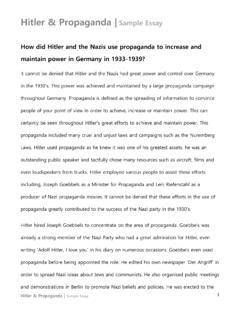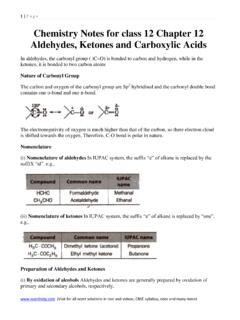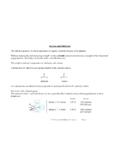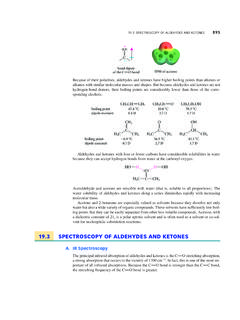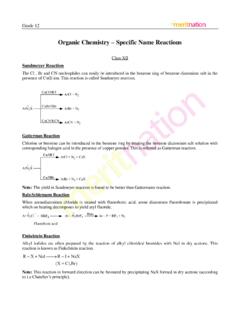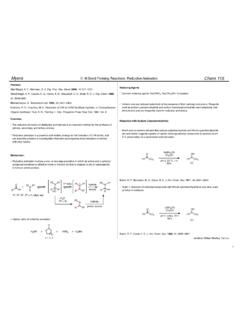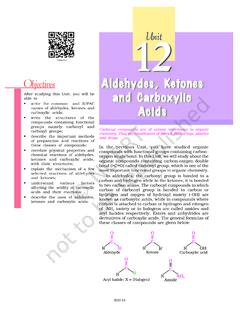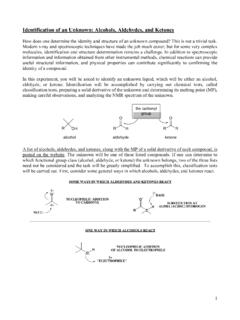Transcription of Organic Chemistry | Topic Notes - .NET Framework
1 Organic Chemistry | Topic Notes 1 Organic Chemistry | Topic Notes Organic Chemistry is the study of compounds of carbon. A functional group is an atom or group of atoms which is responsible for the characteristic properties of a series of Organic compounds. Organic Chemistry Table Homologous Series Functional Group Structure of Group Name Example Alkane Single bond - Propane Alkene Double bond !Unexpected End of Formula Propene Alkyne Triple bond Propyne Chloroalkane H s replaced by Cl s - Cl Chloropropane Alcohol Hydroxyl - OH Propanol Aldehyde Carbonyl (end) - C=O(H) Propanal ketone Carbonyl (middle) - C=O Propanone Carboxylic Acid Carboxyl - C=OOH Propanoic Acid Ester Bridging oxygen -COO- Methyl ethanoate 2 Hydrocarbons: Compounds that contain carbon and hydrogen only.
2 Saturated: Contain only single bonds. Homologous Series: A series of compounds of uniform chemical type, showing graduation in physical properties with a general formula for it s members. They have a similar method of preparation. Prefix No. of Carbons Meth - 1 Eth - 2 Prop - 3 But - 4 Pent - 5 Hex - 6 Hept - 7 Oct - 8 Non - 9 Dec - 10 Mike Eats Pringles But Prefers Hula Hoops On Nasty Days. Organic Chemistry | Topic Notes 3 Tetrahedral Carbon Compounds Alkanes are tetrahedral carbon compounds. These are a homologous series, most of these alkanes are fairly un reactive and are found naturally occuring.
3 For example Methane can be made in a biomass degenerator, letting manure decay under anaerobic conditions. Methane however forms an explosive mixture with air. A hydrocarbon is a compound that contains hydrogen and carbon only. Many hydrocarbons again, are naturally occuring and have been formed in the earth over millions of years, crude oil, coal A homologous series is a series of compounds of uniform chemical type. Showing gradations in physical properties Having a general formula for all of its members Each member differs from the previous member by a CH2 unit.
4 Tetrahedral bond angles = 109 degrees There are 3 types of tetrahedral carbon compounds on our course: Alkanes Alcohols 4 Chloroalkanes Organic Chemistry | Topic Notes 5 Alkanes - Shape: tetrahedral - never planar. - Bonds: All single bonds - saturated. - General Formula: CNH2N+2 - Ending: -ane (eg: propane) CH4 - Methane C2H6 - Ethane C3H8 - Propane H H H H H H | | | | | | H -- C -- H H -- C -- C -- H H -- C -- C -- C -- H | | | | | | H H H H H H Carbon Carbon single bonds.
5 C---C functional group They are saturated. This means that they undergo substitution reactions. This will be described later (free radical substitution and saponification). Meth - ane Eth - ane Prop - ane But - ane Pentane - ane Hex - ane Hept - ane 6 Oct - ane Non - ane Dec - ane It is important to remember 2,2,4 trimethylpentane or iso-octane and Cyclohexane as these are important in fuels. Structural isomers are compounds with the same molecular formula but different structural formula. They differ in physical properties, boiling points.
6 An example is Butane ------ Methylpropane It is important to know the use of alkyl groups when asked to form an isomer. An alkyl group is an alkane molecule from which a hydrogen atom has been removed. CH3 - methyl group C2H5 - ethyl group C3H7 - propyl group Organic Chemistry | Topic Notes 7 Alcohols A homologous series similar to alkanes but with a hydrogen replaced by an -OH (hydroxyl) group. The ending is -anol (eg: propanol). The general formula is CNH2N+1OH. There are primary, secondary and tertiary alcohols. Primary alcohols are when the carbon attached to the hydroxyl group touches one other carbon.
7 Secondary alcohols are when the carbon attached to the hydroxyl group touches two other carbons. Tertiary alcohols are when the carbon attached to the hydroxyl group touches three other carbon. *Always indicate the position of the hydroxyl group when naming alcohols. For example 2methylbutan-1-ol which has a methyl group attached to the second carbon and the hydroxyl group is attached to the first carbon. The hydroxyl group of the alcohols changes their Chemistry drastically from their corresponding alkanes. In particular, it affects their boiling points and solubility.
8 Boiling Points 8 The hydroxyl group (-OH) undergoes hydrogen bonding, resulting in them having very strong bonds. As a result, their boiling points are higher than those of the corresponding alkanes as it takes more energy to break apart the bonds. Solubility The solubility changes as the length of the carbon chain increases. The OH group is highly polar and if the chain is short it forces the non-polar carbon chain to dissolve in polar substances such as water. If the chain becomes too long the OH group can no longer force the chain to dissolve in polar substances so it dissolves in non-polar substances instead (cyclohexane).
9 (Like dissolves like.) -OH is the functional group. Called the Hydroxyl group. Remember - alcOHol General formula is CnH2n+1OH (alkyl + OH group) The -OH group is V shaped and the shape around each carbon atom is tetrahedral. Alcohols are named by replacing the -ane from its corresponding alkane with -anol Primary Alcohol - Where the carbon atom joined to the -OH group is attached to only ONE other carbon atom. Ethanol & Methanol. Secondary Alcohol - Where the carbon atom joined to the -OH group is joined to TWO other carbon atoms. propan-2-ol Tertiary Alcohol - Where the carbon atom joined to the -OH group is joined to THREE other carbon atoms.
10 2methylpropan-2-ol. Organic Chemistry | Topic Notes 9 Ethanol found in alcoholic drinks is formed by fermentation, fruits with glucose have yeast added to them (catalyst=zymase), the sugar forms a solution of ethanol and carbon dioxide as a result. These kind of drinks like wine contain 10% - 12% v/v ethanol, once ethanol reaches this percentage it kills all of the yeast and fermentation stops. Therefore fermentation alone DOES NOT produce drinks greater than 12% v/v. To increase alcohol concentration, fermented liquids are distilled. Wine is distilled to brandy.





